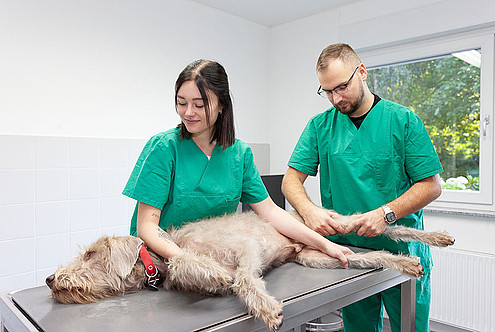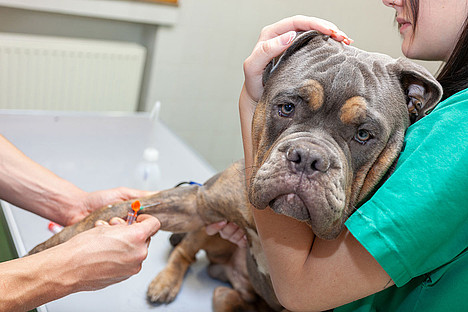Services and Diagnostic Possibilities at Tiermedizin Hochmoor
Dermatology (Skin Conditions)
The prevalence of skin conditions in domestic animals is constantly on the rise. Allergic responses often cause skin irritation but a number of parasites and fungi also impair the well-being of our domestic animals.
Among others, examination methods for skin conditions are
- flea detection
- allergy testing
- mycological culture
- skin scraping for detection of parasites
- blood counts
- cell counts
- examination of skin tumours.
Endocrinology (Hormonal Disorders)
Diabetes, hyperfunction of the adrenal gland in dogs and thyroid hyperfunction in cats are among the most common hormone-induced disorders in small animals. Furthermore, thyroid and adrenal gland hypofunction occur frequently in dogs.
At our laboratory, hormone tests are evaluated. In addition, ultrasonographic examination of the affected organs is often needed. Blood counts are also frequently required.
Cardiology
Cardiac disorders are common in small animals. In order to make an accurate assessment of the cardiac and circulatory situation, several examination methods are required.
On the basis of these examinations, cardiac function can usually be sufficiently assessed. Treatment which prevents progression of cardiac dysfunction and improves cardiac efficiency is then individually tailored to the patient.
Cardiological examination consists of a general clinical examination, an ECG (electrocardiography), radiographic examination of the thorax and cardiac ultrasound.
Orthopaedics
Next to fractures or ligament tears (cruciate ligament tear) due to traumatic injuries, arthritic changes in the joints or disorders in the area of the intervertebral discs can cause pain and paralysis. In all of these cases, radiography and in special cases computed tomography are valuable diagnostic measures in addition to a thorough clinical examination. Computed tomography is a further diagnostic method which works using x-rays and is usually applied when a certain area of the vertebral column or a limb requires closer examination.
More information under Computed Tomography
![[Translate to English:] Kleintiermedizin Hochmoor [Translate to English:] Kleintiermedizin Hochmoor](/kv/_processed_/7/e/csm_Kleintiermedizin-Hochmoor_c796a9e531.jpg)
![[Translate to English:] Klinik für Pferde [Translate to English:] Klinik für Pferde](/kv/_processed_/0/d/csm_pferdeklinik-01_c18cc541af.jpg)
![[Translate to English:] Allgemeine Untersuchung Kleintier [Translate to English:] Allgemeine Untersuchung Kleintier](/kv/_processed_/1/5/csm_allgemeine-Untersuchung-Kleintier_cdba7ebb98.jpg)
![[Translate to English:] Lahmheitsuntersuchung Pferdeklinik Hochmoor [Translate to English:] Lahmheitsuntersuchung Pferdeklinik Hochmoor](/kv/_processed_/2/e/csm_Lahmheitsuntersuchung-Pferdeklinik-Hochmoor_8e9ec18025.jpg)

![[Translate to English:] Tiermedizin Hochmoor CT Hund [Translate to English:] Tiermedizin Hochmoor CT Hund](/kv/_processed_/6/4/csm_Kleintiermedizin-3_56aa5d056b.jpg)
![[Translate to English:] Tiermedizin Hochmoor Kleintiermedizin [Translate to English:] Tiermedizin Hochmoor Kleintiermedizin](/kv/_processed_/d/e/csm_Tiermedizin-Hochmoor-Kleintiere_5f8df77a2f.jpg)
![[Translate to English:] Pferdemedizin Hochmoor [Translate to English:] Pferdemedizin Hochmoor](/kv/_processed_/5/6/csm_Pferdemedizin-Hochmoor_2a06563c44.jpg)

